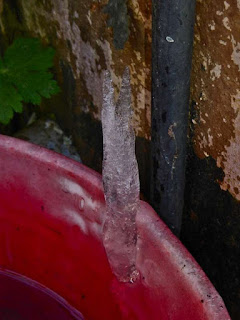Firing the wood fired kiln 05, cones and chart.
 What strange food is this little clay bird trying to eat? Could it be some sort of worm caught in a trap? No, it is a row of used Orton Pyrometric Cones.
What strange food is this little clay bird trying to eat? Could it be some sort of worm caught in a trap? No, it is a row of used Orton Pyrometric Cones. Here is another selection, used cones on the left, and new cones on the right. You may not be able to read it in the photo, but each cone has a number on it. The cones in each set are numbers 9, 10, and 11. (The birds are from an evening class that I teach)
Here is another selection, used cones on the left, and new cones on the right. You may not be able to read it in the photo, but each cone has a number on it. The cones in each set are numbers 9, 10, and 11. (The birds are from an evening class that I teach)Warning...The following content could be a bit boring, but..., it is designed to fill in some of the gaps in the previous 4 kiln firing posts. Children ask your parents first. Conditions apply.
Cones give an indication of what is happening in the kiln, and are useful to the potter as they measure heat work and give a good indication of what is happening to the pots and the glazes. They record the journey from lighting the kiln, to the point when they bend over. A slow rise in heat will cause the cone to flop over at a lower temperature than a rapid rise. It is a bit like putting your hand in water that is too hot. A quick immersion may not do any damage, but hold the hand in for long, and the result could be painful.
Cone 9 is designed to bend over at 1257 C (2294 F),
cone 10 is 1282 (2339 F),
and cone 11 is 1293 C (2359 F).
(The temperatures above are accurate for standard Orton cones if the rise in temperature in the kiln has been 60 degrees C per hour for the last 100 degrees (140 F per hour for the last 212 F). Where the rise in temperature has been less, the cones will bend at lower temperatures. In this firing the last 100 degrees C took 3 hours, which is an average of 33 degrees C per hour.)
Wood fired stoneware, 30 May 2009.
 The kiln was warmed with small fire to an indicated 120 C from 4.30pm to 11pm on the evening of May 29th. Temperatures are in centigrade and are in hundreds. Note that my very much second hand pyrometer was out by a considerable amount towards the top end of the range, so the temperatures are a very rough indication of progress only. The firing continued until cone 11 was down. At a guess the indicated top temperature of 1190 degrees C (2174 F) may have been 80 or more degrees Centigrade (176 F) lower than it actually was.
The kiln was warmed with small fire to an indicated 120 C from 4.30pm to 11pm on the evening of May 29th. Temperatures are in centigrade and are in hundreds. Note that my very much second hand pyrometer was out by a considerable amount towards the top end of the range, so the temperatures are a very rough indication of progress only. The firing continued until cone 11 was down. At a guess the indicated top temperature of 1190 degrees C (2174 F) may have been 80 or more degrees Centigrade (176 F) lower than it actually was.The yellow areas on the graph show where the kiln was fired in oxidation. Pale orange show alternating reduction atmosphere and some oxidation, and dark orange is heavy reduction.
The sort of cones that potters use today were invented by Hermann Seger (1839-1893) in 1886, towards the end of his short life. Seger was director of a laboratory at the Royal Porcelain Works in Berlin, and he made his cones from the same material as porcelain glazes, namely feldspar, calcium carbonate, quartz, and kaolin.
Hopefully, we should be unpacking the kiln tomorrow.


Comments
The Good news is..... A Great Result!